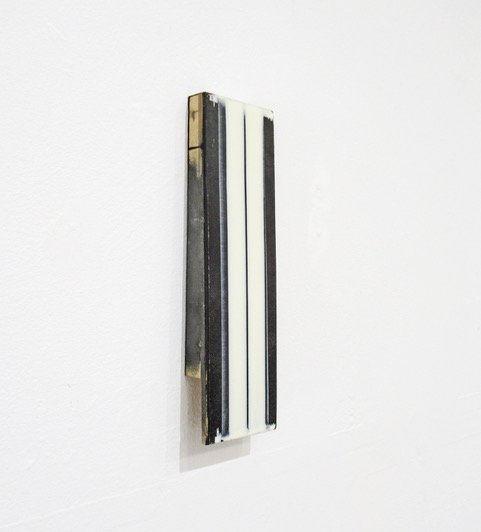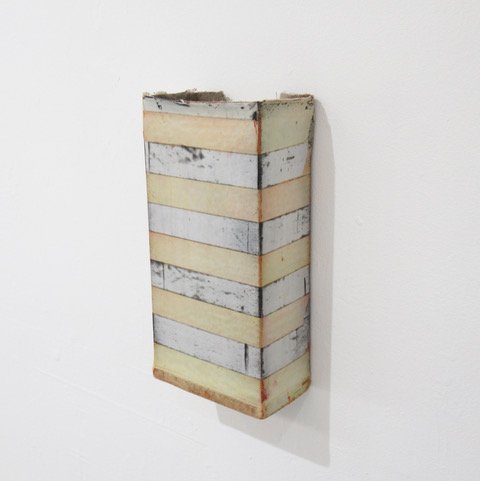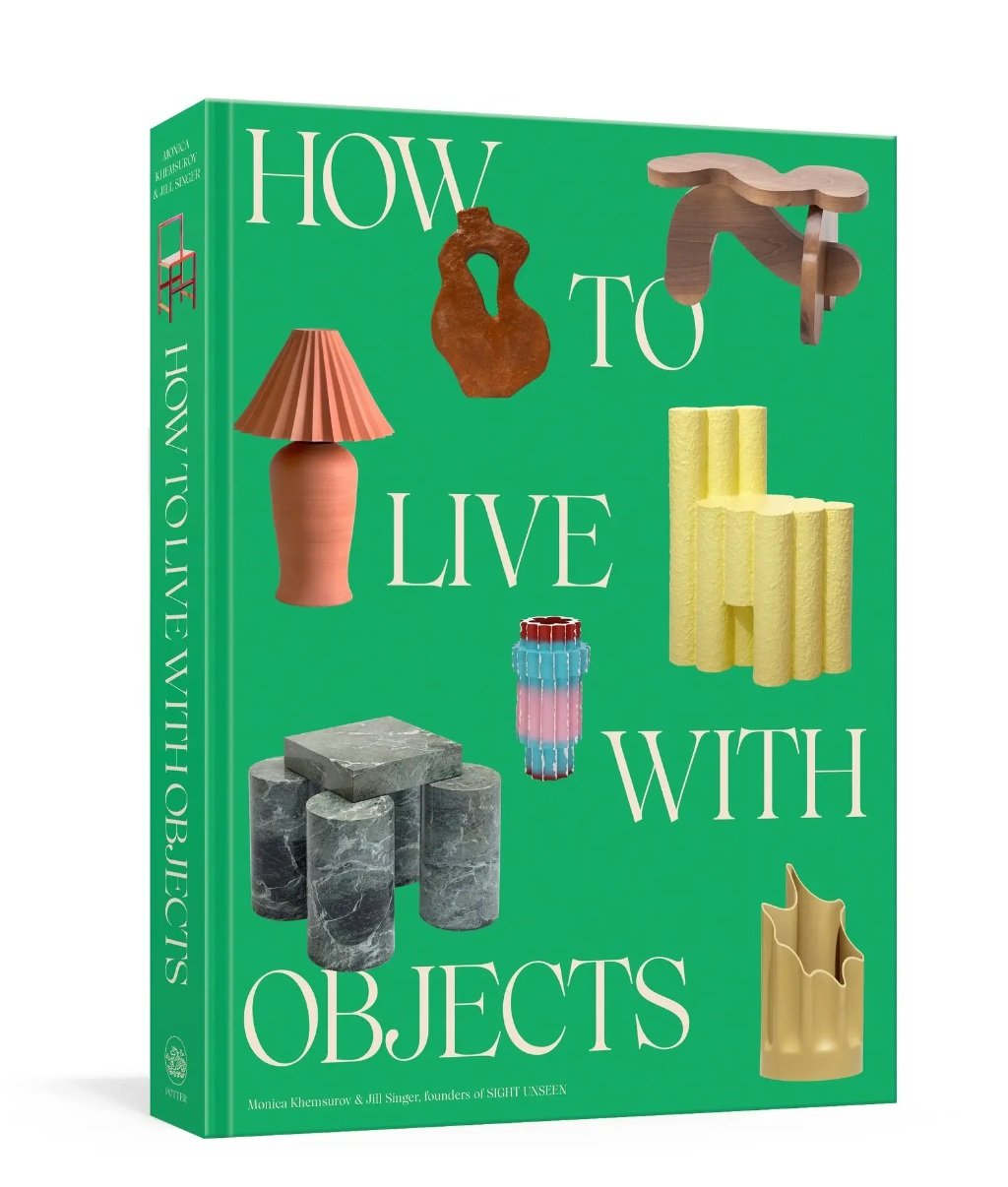13 | Artist profile: Ben Dallas
The Weakness of Symbolic Accuracy 2023 9.5”x4.5”x3” Acrylic Media, Canvas, Glue, Wood
Photo: James Hart
What part of the country did you grow up? (urban/rural) and how did that impact your childhood?
Until about the age of eight I lived in rural Southern Kentucky without indoor plumbing and electricity. I attended a one-room schoolhouse barefooted. My childhood was perfect because I knew nothing to which I could compare it.
What was the cultural or creative make up of your family?
Mine was a working class family. Both my mother and father worked sometimes at two jobs. They liked country music and would take me and my brother to outdoor concerts. With the exception of a reproduction, a sentimental scene of an old man praying at a table, and my mother’s small, decorative pictures of birds made from actual bird feathers, there was no visual art in the house that I can remember.
Do you remember the first art work/music/book/film that impacted your imagination?
My first art experiences were those of music, not visual art. When I was very young, 4 or 5, I would listen to and watch relatives and their friends play country and bluegrass music usually on someone’s front porch.
What initially draws or strikes one with your paintings and objects are the edges and profile – the juxtaposition, the unravelling, the crisp edge. Where do the forms originate from and how do they interact with the viewer?
Most of my works originate from an intention to deconstruct what traditional paintings have been. I invent alternatives to their conventions of painted surfaces placed frontally and traditionally held in frames of secondary visual interest. My pieces have normally been combinations of flat painted surfaces juxtaposed dimensionally. As such, they bridge the categorical gap between painting and sculpture. The painted surfaces I combine very seldom appear flat as I pursue some degree of pictorial effect, some kind of implied or illusion of space. The objects resulting from this fixed union of painted parts in three dimensions demand some degree of participation from their viewers. They require and direct a viewer’s movement to reveal themselves. The wall-mounted pieces I make are intended to be scrutinized, to play their parts in an animated and intimate encounter of seeing and contemplation.
While They Waited For Something Else 2023 7.75”x4”x.75”
Photo: James Hart
With the most recent series there is an organic, casual yet intentional handling of the canvas(es) and materials. How did this motif and series evolve?
My art objects are constructed as an integration of all their parts, even those hidden from view. Traditionally, much effort has been made to minimize a painting’s structural components from sight especially when painted surfaces were used primarily for representation, but artists have long recognized painting’s physical duality and explored alternative possibilities for what paintings can be. When exposed and intentionally included, its structural elements can play an important role in transforming traditional painting into something less familiar, extending it into more complex aesthetic objects where a variety of painted effects are integrated with numerous structural configurations. My recent series of works involve shaping glued layers of canvas into configurations which are self-supporting, an integration of surface and structural foundation.
Your titles are funny and complicated, How do you think about titles and your work? Are there literary references or writers that have informed this?
Since the art I make is intended to be autonomous, made to escape referential connections, I’ve often used “Untitled” to name my works. I have also titled my works for what they physically do like “Turn,” “Bend,” “Face,” and “Fold.” In recent years I’ve begun to just make up titles, not so much in connection with the pieces they’re attached to, but more so for cataloging the work, distinguishing one from another. On days when I’m feeling poetically creative I just make up titles and add them to a list. Most if not all result from mental wanderings and emotional states, my vague mostly negative relationships to the world and the opinions I have of it. Seldom am I conscious of any specific literary source from which my titles are derived. I do like that they can appear to have a life of their own standing at odds with works to which they’re applied. In some perverse way I also like the obvious confusion resulting from any serious attempt to connect a work with its distant title, maybe my way of emphasizing autonomy.
What historic artist or movement do you return to again and again?
My studies of art history have given me a rather large array of artists and movements from which to develop favorites. At various times in my life I’ve been exceptionally fascinated and drawn to some artists more than others. My fondness for Jan Vermeer has remained constant as has my interest in Marcel Duchamp, Jasper Johns, and Andy Warhol. My personal aesthetics have been developed and exercised from Minimalist object makers like Jo Baer and John McCracken.
What contemporary artists or museum are you inspired by?
I find all art museums wonderfully fascinating. They inspire me, but also make me a little sad. After grad school I worked in a major museum for a few years, long enough to realize the immense richness and complexity which art museums embody. I believe my sentimental feelings from museum experiences stem from choosing not to devote my working life to the demands of curatorial research.
I respect so many contemporary artists, too many to list. Gerhart Richter’s nonobjective paintings are breathtaking. His ingenious play of imagery between representation and photography based abstraction is amazing. In addition, I’m exceptionally moved by the works of Jenny Saville and Leonardo Drew.
Skew 6. 2019 10.5”x3.13”x1.5” Acrylic Media, Board, Wood
When you are feeling stuck or unmoored, what do you do to shift the energy?
I seldom get stuck, but sometimes when I feel tired of working within a serial sequence of objects I take a day off from the studio. When I return I look for inspiration from studio debris. The residue from previous constructions usually presents possibilities for
new work. Also, while away from the studio I normally get numerous ideas for what to make usually before going to sleep. These are normally formulated from thinking about the materials with which I’m presently working. Most ideas are discarded, some are tried.
When you are getting ready to start a new piece or series, how do you begin? With materials? Color? A title?
I can have preconceived notions of what to do, but new work begins when I get my hands on actual materials. My art is made by a sequence of aesthetic judgements: what goes with this or that, is the combination doing something visually interesting and exciting, and how can the components be physically joined together as a viable part of the piece.
Do you listen to music in the studio? What have you been listening to recently, or what has been touchstones?
My taste in music is eclectic. I like most anything with the exception of most commercial pop. I make playlists on Spotify for studio listening. A recent combination of tunes includes: The Ex, Liaisons Dangereuses, Front 242, Talking Heads, DAF, Devo, and Lou Reed.
I love Classic Rock, Folk, old Blues, Lofi, Classic Country, Industrial, Contemporary Classical ( Philip Glass), Klezmer, Roots, and just about anything else. I always return to Dylan, Leonard Cohen, early Stones, Tom Waits, John Prine, Radiohead, Talking Heads, and early Phosphorescent. I’m sure I’ve left out some favorites.
Do you surround yourself with reference materials or colors? What does your studio look like?
My studio is white with track lighting and some power tools. It has racks for storage, a small metal table with white chair, and a hanging plant under a skylight.
A few show cards and printed matter is kept on the table. The only real reference material is the array of discarded pieces of wood and other various stuff which fills a large bin.
You moved to Santa Fe after a teaching and art career in Chicago – how has that impacted your life, and what is your favorite thing about living there?
Moving to Santa Fe was a way to begin a new life phase. When I turned seventy I realized that if I didn’t personally initiate changes there would be none. I live differently in Santa Fe. I share my life with a partner and a dog. I have fewer social activities, less immediate friends with whom to interact. While, to some, this might sound isolating, for me, it’s been an opportunity to focus on my art making and my own well-being.
At the end of a studio day, how do you extract yourself? Any closing rituals or routines?
I do have a routine at the end of my studio day. I vacuum up excess dust, turn off music, pull down the overhead door which covers the large window, turn off the track lights, and lock the door.
A Fundamental Set Of Absurdities 2023 11”x8.75”x 3” Acrylic Media, Canvas, Glue
Photo: James Hart
12 | a book + links
recommended reading
Have a beautiful weekend
Recommended reading | The Weather by Lisa Robertson
Here’s a fantastic discussion of the work from the Writers House | Penn University
I learned so much from this lecture series about art Pictures of Nothing
How to act around books via swissmiss
This exhibition just opened at MOCA Tucson, down the street from the studio. Cecilia Vicuña (b. 1948 in Santiago, Chile; lives and works in New York and Santiago) received her M.F.A. from the National School of Fine Arts, University of Chile in 1971 and continued with postgraduate studies at Slade School of Fine Art, University College London from 1972-1973. Vicuña is the author of 30 volumes of art and poetry.
Check out Namu Home Goods by Diane Ryu. The wood objects are sourced from Korea.
Edmund de Waal’s studio
11 | a field guide: five gardens to visit Tucson, AZ
Every time I go Hiking, I wish I knew more about the plants that I am looking at. If you feel ths same - here are five amazing gardens\living museums to start with. The list includes Botanic Gardens and National Monuments, some are inside the city limits, and one (the Sonoran Desert Museum is just a spectacular drive away from the city) through the North Tucson Mountains. Make sure to add time for stopping along the way.
The Arizona Desert Museum is inside of the Saguaro National Forest, It is a great place to take a date, friends or families to look at plants and animals up close and personal without worrying about packing water and all of the gear needed for a hike in the Desert. Although it is best to have a hat, sunscreen and water with you at all times. The sun is particularly intense in Southern AZ.. The plant collections are incredible. I like going through the hummingbird house and the bird aviary. Gambel Quail are on the ground - it’s so cool to hear them burbling in the undergrowth.
Saguaro National Forest - West Side
The Tucson Botanical Garden is a quiet place to spend late afternoon watching the color changes and birds and insects floating through the pollinator gardens. They have a gorgeous butterfly and orchid pavilion. The plant collection is well maintained - my favorite area is the Cactus and Succulent garden and the citrus grove in the winter. The smell of lemon and orange blossoms are intoxicating.
Entrance buildings at The Tucson Botanical Garden
The Mission Garden is a living agricultural museum. It has recreated gardens based on all of the peoples who have lived and moved through the Sonoran Desert and Tucson. It is a great resource for questions about food culture, history and native plants. They host an annual Agave Festival in the Fall, with demonstrations of food and drinks that come from the great agave.
The Mission garden sells a ‘Mission Black Fig’ tree. Mission instagram
Tohono Chul is a 37 acre botanic garden with a nursery, gift shop and bistro. They have music in the gardens with world class musicians. The nature trail walk goes through mature saguaros. I have never seen the great horned owl pictured below, but wouldn’t that be thrilling?
You may get lucky and see a great horned owl at Tohono Chul. Tohono Chul
10 | a book + links
recommended reading
Choosing and living with hand made or design objects can be daunting, but if you follow your intuition and allow yourself to have fun, you can become a thoughtful supporter of makers and designers everywhere while enriching your life. Reframing the purchase of something significant from the burden of owning it forever also helps, I have certain things that I could never part with, but there are other objects or artwork that will pass through my hands and space. Museum shops are a great place to start looking at art, jewelry and objects - and from there, small boutiques, galleries, antique markets and estate sales are so much fun.
The duo behind the Design blog Sight Unseen just released a book called How to live with Objects . The NYT reviewed this book and highlights their ability to identify upcoming trends. In defining their style… “It’s really ineffable in some ways, and it’s come back to us, when people say things are ‘so Sight Unseen,’” Ms. Singer said. “It can mean a lot of different things to a lot of different people. There is just some weird, undefinable quality that’s hard to explain.” In Ms. Khemsurov’s estimation, “It’s just interesting enough, but not too crazy.” Their website is filled with fascinating insights on design and trends. I loved reading this post on What it’s like living in a Schindler house.
A few SW places and websites that I love to frequent
one way of reusing cloth with Christina Kim of Dosa Flying Fish
09 Field Guide | old city, Philadelphia
A field guide to old city, Philadelphia PA
Philadelphia | neighborhood guide to old city.
Quiet in the land image by Marley Parsons
I returned to Phialdephia for an exhibition of drawings at Gallery Land Collective. ( On view through November 30.)
Old City is one of my favorite neighborhoods in town. I highly recommend a visit to this part of the city, It is always evolving. It is part of Philadelphia’s historic district, and it spans from Vine Street to Walnut Street, north to south, and from 7th Street to the Delaware River, west to east.
The material culture down here is so unique, and typical of the earliest East Coast cities. Brick, granite, marble, slate, terracotta, cast iron utility covers, and single pane windows. A painter friend picked up paint chips from the buildings to create a color palette. The historic heart of Philadelphia resides along Independence Mall. Home to Independence Hall and the Liberty Bell Center, the Mall also boasts a number of cultural institutions including the Philosophical Society Library and Archives, The National Jewish American Museum , and Ben Franklin’s house. Be sure to stop by the Independence Visitors Center for tickets to city attractions and helpful information.
Shoppers can find lots to love along Second and Third Street, I love how there are hardware stores and an abrasive supply shop tucked in between cafes and galleries. Here are a few of my favorite places to check out.
sidewalks and building materials
Shops
Vagabond Boutique: A cool boutique that has understated leather goods, clothing, jewelry and more.
Art in the Age of Mechanical Reproduction: Hand Tasting room and home bar supply - also great graphic tees.
Claudia Mills: So fun to see a bunch of looms set up in the showroom.
Sugarcube: Updated classics by indie designers & the shop's private label, showcased in an industrial loft. The coolest clothing and accessories.
United by Blue: I have heard good thingsm, about this one, but haven’t gotten there yet.
Christ Church on Second Street has a dog park next to it, and benches all around to take in the city.
Galleries and Design Studios
Antique tools for cultivation. David Rubin and Land Collective
Larry Becker Contemporary: Represents and exhibits abstract and conceptual contemporary art in various mediums, with an emphasis on painting. Emerging, mid-career, and internationally recognized artists, many Philadelphia-based.
Center for Art in Wood: contemporary collection of functional and sculptural wood.
Muse Gallery: In a city of firsts, Muse is the oldest cooperative art gallery in Philly; 52 N. 2nd St. Monthly rotating exhibitions by members
Land Collective: David Rubin and Land Collective are a landscape architecture and planning firm. David’s personal collection of garden tools and objects are well displayed. They have an open studio every First Friday and host art exhibitions in the lobby.
Food + Drink
Cafe ole: The Best Mediterranean mezze plates, sandwiches and salads. Don’t miss the hummus.
Tomo Sushi and Ramen: I stopped in for a quick avocado roll and it hit the spot!
Old City Coffee: When you need a simple cup of joe, it’s right behind Christ Church, so head towards one of the benches and regroup.
Fork Restaurant and Bar: You have to cross Market Street to find the bars, and there are plenty on Second Street, I prefer Fork. The bar is in the center of the restaurant - made of cast concrete (the old fashioned comes highly recommended on a dark and rainy night).
This is just scratching the surface of what is available in this diverse neighborhood. Please let me know your favorites in the comments below.


















